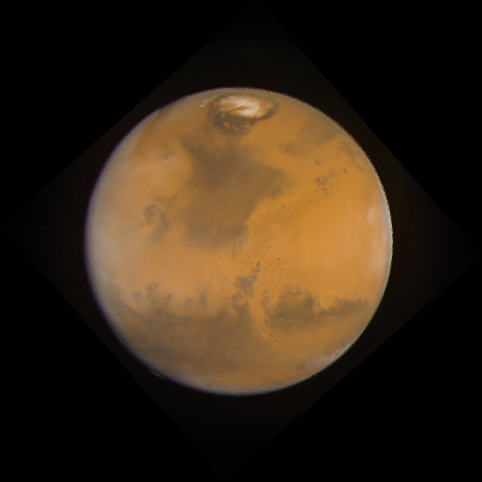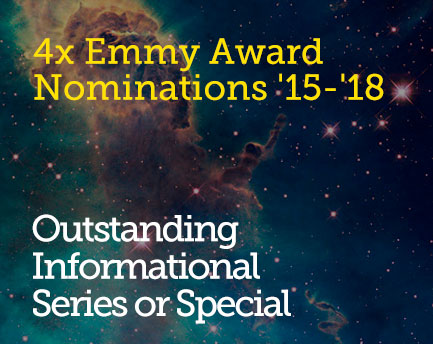April 2, 2014 7:47 pm
From Mars to Meteors, April Is a Great Month for Looking Up

From Hubblesite.org: This “true-color” image of Mars shows the planet as it would look to human eyes. It is clearly more earth-toned than usually depicted in other astronomical images, including earlier Hubble pictures. Photo Credit: Jim Bell (Cornell University), Justin Maki (JPL), and Mike Wolff (Space Sciences Institute) and NASA
From the largest worldwide celebration of astronomy, to a close-up of Mars, a lunar eclipse, and the Lyrid Meteor Shower, if the weather cooperates, this month could be a great month for getting outside and celebrating the cosmos.
Global Astronomy Month
To start with, it’s Global Astronomy Month, the worldwide celebration of astronomy sponsored by international astronomy advocacy organization Astronomers Without Borders. They’ve got some interesting events planned, including a live online observing event to watch the asteroid Vesta on April 10, which at the time of observation will be brighter than magnitude 6. You can find out more about AWB, and the month-long celebration, here.
Mars in Opposition – April 8 & April 14
According to EarthSky, April 2014 is the best time in two years to see Mars. That’s because not only will Mars be in opposition to the sun (i.e., Mars and the Sun are on opposite sides of the sky, and we’ll pass between them), but also Mars and Earth will be separated by only 92 million km, the closest we’ll come during an opposition until 2018, and closer than we were in 2012.
The opposition occurs on April 8th, but on April 14th, Mars and Earth are closest. Also, that same night, there’s a total lunar eclipse, during which “ the blood-red eclipsed full moon will appear next to blood-red Mars.” To make sure you get the most out of Mars, check out these two excellent articles on EarthSky: When to see Mars in 2014 and Mars opposition happens this month: It’s really easy to see.
Lunar Eclipse – April 14-15
The first total lunar eclipse of the year (actually, the first we could see since Dec. 2011) happens on the night of April 14-15, starting around 12:37am EDT on April 15th. According to Universe Today, “Totality will last 1 hour, 17 minutes and 48 seconds, and will be visible in its entirety from the central Atlantic westward to eastern Australia. Unlike a total solar eclipse, which occurs along a narrow track, a total lunar eclipse can be viewed by the entire moonward facing hemisphere of the Earth.” You can read their whole viewing guide here.
Lyrids Meteor Shower – April 16-25
The Lyrids will arrive on April 16th and last until April 25th, with their peak April 21-22. According to MeteorWatch, the best time to see them is after midnight and before dawn. While the Lyrids have had as many as 100 meteors per hour at peak in the past, expectations this year are for only about 20/hour.
Global Selfie for Earth Day – April 22
NASA is inviting people all around the world to step outside on Earth Day, April 22, take a “selfie,” and share it with the world on social media. Why? According to NASA, it’s to celebrate a milestone: “For the first time in more than a decade, five NASA Earth-observing missions will be launched into space in a single year.” Whatever the reason, it’s the latest in NASA’s efforts to get more and more people excited about space exploration, so all we have to say is, “Look up, point the camera at yourself and say ‘Cheese.’” Find out more here.
Annular “Ring of Fire” Solar Eclipse – April 29
Don’t get your hopes up for this one unless you’re in the southern hemisphere, and even then, this one is unusual. According to Sky and Telescope, “Occasionally the Moon passes directly in front of the Sun but doesn’t completely cover it. This circumstance is known as an annular eclipse, so-called because you can see a ring, or annulus, of sunlight surrounding the lunar disk.” This year’s “has a rare, peculiar geometry: from nowhere on Earth does the Moon’s silhouette appear to be a perfect bull’s-eye on the Sun’s disk. Instead, an off-centered ring, lasting just 49 seconds, is visible only from a tiny bit of Antarctica — a viewing site so remote that annularity might go unseen by human eyes.” However, if you’re in Australia, you’ll get a partial solar eclipse peaking around sunset.
Northeast Astronomy Forum – April 12-13
Oh, and this month is also NEAF, the Northeast Astronomy Forum, April 12-13 at SUNY Rockland Community College in Suffern, New York. We’ll have a booth there again this year… and more details about that on the blog next week. Until then, you can find out more info here.
Now that’s a busy month. If we missed something, let us know below in the comments.
That’s it for now. Keep Looking Up!
–Jeffrey Simons
Get the most out of StarTalk!
Ad-Free Audio Downloads
Ad-Free Video Episodes
Stickers & Mugs
Live Streams with Neil
Priority Cosmic Queries
Early-Access Videos
Learn the Meaning of Life
...and much more

 Become a Patron
Become a Patron

